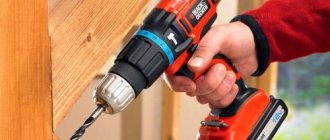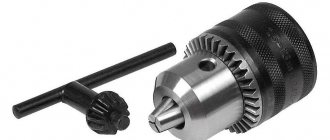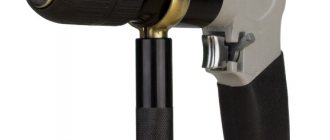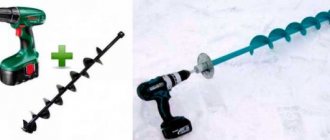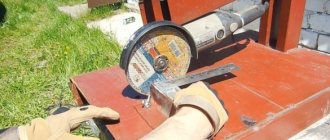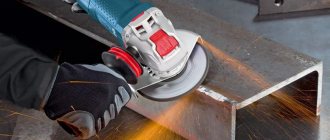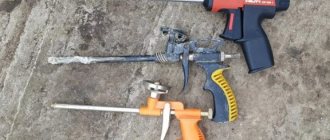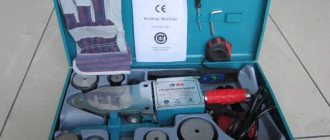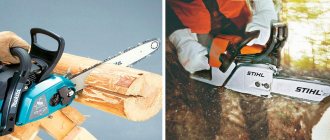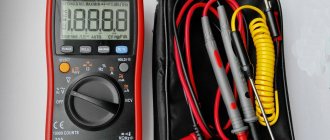Description of the screwdriver
A screwdriver is a pistol-shaped hand-held power tool for tightening/unscrewing screws, self-tapping screws, screws and other threaded hardware with slotted and hexagonal heads. It is used in everyday life and in production for installation/dismantling of furniture, fences, roofs. If special equipment is available, surfaces are ground and holes are drilled. Operates from an electrical network or battery - some versions (pneumatic) operate on compressed air. The device as a whole consists of a housing, a mounting unit, mechanical and electrical parts, as well as adjustment and protection systems. Main structural elements:
- plastic or metal body with rubberized handle;
- an electric (pneumatic) motor performing rotation;
- planetary gearbox: creates a transmission from the motor to the spindle with a chuck;
- an adjusting coupling adjacent to the gearbox;
- clamp cartridge for fixing attachments;
- electronic control unit with start button and reverse switch;
- battery: present only in models of the same name.
First, a bit with a 6-sided shank is inserted and fixed into the chuck; the clutch sets the tightening torque (there are from 8 to 25 positions); A corded screwdriver, unlike a cordless screwdriver, is connected to an outlet. When you press the start button, the engine starts, which, through a planetary gearbox, begins to rotate the spindle with the chuck and bit - the stronger the force, the higher the speed. After tightening the screw, the resistance to rotation increases, as a result the ratchet slips and the transmission stops. When unscrewing the hardware, the reverse is activated - the equipment begins to work counterclockwise.
Why do you need a screwdriver?
When drills began to be equipped with batteries, they were often used as screwdrivers. The ability to autonomously use devices of this type is very useful when performing work in confined spaces. You may also need a screwdriver for assembly work on metal and wooden structures.
Such a tool has few external differences from a drill. However, its design is developed specifically for the effective tightening and unscrewing of screws, screws and self-tapping screws. There are models of screwdrivers that can be used when drilling various holes. Screwdrivers are designed in a way that allows for lighter torque. When working with screw connections, high rotation speeds are not required.
For this purpose, a special device is placed in the device - a gearbox. It allows you to reduce the speed to 300 per minute. In this case, the torque is simultaneously increased. The screw does not become deformed.
To prevent the device from jamming, a special system with several speeds is installed in it, which eliminates overloads. A screwdriver can be equipped with special attachments that allow you to tighten and unscrew various fasteners. An impact driver is capable of tightening nuts and screws using strong impacts.
Important! The presence of a special release coupling allows you to create a screwing force. Thanks to this part, the cartridge stops automatically during overload.
When using batteries that are combined with the handle, the screwdriver is much more convenient to use. Such tools have become quite common in the construction industry. Similar devices are also used for assembly work and car repairs.
Description of the drill
A drill is a hand-held, pistol-shaped electric machine. Designed for making holes in products made of wood, metal (steel), plastic, brick and (reinforced concrete) concrete. Used in construction and repair - at the industrial and domestic level as preliminary installation work. Modern devices, in addition to performing direct functions, “perform” the work of a grinder, grinder, mixer, corded or cordless screwdriver. Unit design:
- plastic (or aluminum) case with a rubberized handle and an additional handle;
- commutator motor with stator, rotor, armature and brushes;
- quick-release chuck that fixes the attachment (drill);
- start button: latches into place during long-term operation;
- speed controller: adjustable depending on the processing material;
- cord with plug for connecting to the mains;
- metal stop rod: controls drilling depth;
- LED illumination of the work area.
Drilling begins with setting the depth limiter and setting the speed: the harder the product, the lower the speed should be. The handle is grabbed and the “start” button is pressed: the direction of the equipment must be along the axis of the hole in perspective. Through the spindle, rotation is transmitted to the gearbox; as a result, the drill plunges into a beam, corner, or reinforced concrete foundation. The work is carried out with technical care, since, for example, a Bosch drill or an Interskol drill develops a speed of ≈ 1300 rpm - plus / minus depending on the model.
Drill/driver
This tool is universal. They can be used to drill and tighten a self-tapping screw without fear of ruining the bit or unnecessarily recessing the head into the material.
There is an adjustable mechanism (popularly called a ratchet) through which the rotation passes. When the specific resistance you set is reached, it simply turns with a click, and the bit remains in place intact.
In addition, a drill-driver differs from a conventional electric drill in that it is equipped with a gearbox with a larger gear ratio. Therefore, with the same engine power, a drill-driver has a higher torque value. This means that, for example, a corded drill/driver with a 400 W motor power will have the same torque as a 700-800 W drill. However, the dimensions will be smaller.
The price for this is a lower number of maximum spindle revolutions. If on drills it reaches a value of 3000 rpm, then on drills-screwdrivers their number is no more than 600-800. And if it is two-speed, then the revolutions will still not exceed 1500 per minute.
Thus, we conclude that a drill-driver is a good universal option, since it can perform most of both drilling and screwdriver work.
However, such a tool will not replace a drill for work that requires high rotation speed of the chuck. This is, for example, drilling bricks, when the work takes place in shock mode. And although some models of drill-drivers have an impact mechanism, due to the low speed it is not very effective.
It is also worth remembering that drills are not only used for drilling, but also, for example, for mixing mortars using a mixing attachment. And here, too, high turnover is required. Therefore, a drill-driver is also not suitable for such work.
It’s worth mentioning separately about cordless drills and screwdrivers. Firstly, drills and screwdrivers are made with a battery, but there are no classic drills with a rotation speed of up to 3000 rpm with a battery.
Secondly, using battery technology has both its pros and cons.
The advantages include the following:
- autonomy of work - that is, the ability to work for a certain amount of time away from power grids with pre-charged batteries;
- no wires, which can be convenient, for example, when working on the roof.
The disadvantages are the following:
- aging of batteries - with frequent use, they usually last no more than 3 years, and if used rarely, they still age and in any case become unusable after 5-8 years, even if they just lie idle;
- inability to immediately begin work if it suddenly turns out that the batteries are discharged.
These are my thoughts on this issue. I hope that after reading the article you understand for yourself what tool you need. Let me finish here - see you next time!
Difference between a screwdriver and a drill
Drills and screwdrivers are excellent at performing the functions for which they were specifically designed. When using a drill, you can carefully and quickly make a hole in a certain material. When using a screwdriver, you can quickly tighten or unscrew nuts, self-tapping screws, and screws.
The differences between these tools are obvious:
- The drill holder in the drill is a quick-release chuck. It is designed for round diameter drill bits. Screwdrivers use holders that are designed for hex shanks of bits.
- A drill, even equipped with an adjustment mechanism, is not capable of ensuring accurate tightening of the fastener. This may damage the screw head or the bit being used. A special clutch is installed in the screwdriver, which allows you to adjust the tightening force. In this case, the self-tapping screw can be easily tightened to the desired depth.
- In drills for drilling work, a torque of 20 Nm is required. The drill rotation speed must exceed 1500 rpm. To tighten the fastener, the screwdriver needs only 50 rpm and 10 Nm.
- Professional drills are operated in continuous mode for much less time than screwdrivers with similar characteristics.
- In an electric drill, you can change the rotation speed. The screwdriver does not provide such a function.
- An electric drill is inert. This means that it still works for some time after turning off. This should be taken into account when performing drilling procedures. Screwdrivers always stop instantly.
All these differences indicate the need to use certain devices exclusively for the tasks for which they were created. A drill-driver is the most common device among ordinary users. Its versatility and simplicity attract home craftsmen.
WHAT TO CHOOSE: A REGULAR DRILL, IMPACT DRILL OR IMPACT DRILL-DRIVEVER
If you are only going to buy one thing, it is better to choose an impact drill/driver. The new bits allow them to do everything that can be done with a regular drill. As a result, you only miss out on the special function of the impact drill - the ability to work with concrete and brick.
If you can afford to buy two tools and you plan to work with concrete and masonry, pay attention to sets consisting of an impact drill and an impact drill/driver. With an impact drill you can drill in the mode of a regular drill, and you will also have an impact drill-driver when you need to properly tighten bolts and nuts or unscrew stuck ones.
If you are not going to work with concrete and brick, buy a set of a drill and an impact drill/driver.
What is a drill
The drill as a tool appeared a very long time ago. Thanks to this tool, it was much easier to make holes in wood and stone. After the invention of the electric motor, the capabilities of such devices expanded significantly. The metallurgical industry also played a significant role in their development. Special drills appeared. This made it possible to create precise holes in various types of stones and types of metals.
Over time, in addition to production, such power tools began to be used for household purposes. Special attachments have been developed that allow grinding of different surfaces.
When abrasive wheels were invented, the drill began to be used for cutting work. Typically this tool function is used for cutting pipes and metal rods. The latest models of drills have fairly high power and drill rotation speed. The compactness of the devices is also important.
With a wide variety of drill bits and attachments, drills can be used for a variety of purposes. For example, when using special attachments, you can stir different mixtures. Some drills are equipped with an impact mechanism. They are usually switched to this mode when working with concrete products or stone.
Over time, such tools were divided into professional and household. The former are characterized by high reliability and long service life. They use rolling bearings. The parts of such devices are made of alloy steels that are processed at high temperatures. To ensure reliable protection of the insides of such instruments, their body is made of high-quality plastic, which is highly durable. Drills often have a hammer drill function.
High-quality drills are made in a convenient shape, which allows you to work with them as efficiently as possible. When using such devices, the worker’s hand does not get tired, and all actions are performed as accurately as possible. Drills also have another purpose - unscrewing self-tapping screws. This versatility often attracts home craftsmen. To understand the difference between a drill and a screwdriver, you need to take a closer look at the features of each of these tools.
Types of drills and screwdrivers
Variety of screwdrivers
Tools for installing / dismantling self-tapping screws are different - depending on various criteria, they are divided into types.
- The corded screwdriver has a cord with a plug, connects to a socket (220 V), and does not depend on the operating time. It weighs little, is relatively inexpensive and can be used for a long time. But it is useless when the electrical network is not available.
- The cordless screwdriver runs on batteries, is easy to use, and is not “tied” to mains electricity. But it weighs more and is more expensive compared to its previous analogue. Requires periodic charging.
- Household models are relatively cheap, but have low power and meager equipment. Rarely used; When working you need long breaks.
- Professional versions are more powerful - they can work an entire shift without stopping. They are equipped with wear-resistant parts and are more expensive.
The devices are also divided according to the features of use. You can buy a screwdriver along with a cable and a battery. Available in versions for hex shank drills and grinding attachments. Modifications with impact function and pneumatic drive are available.
Variety of drills
Modern drills are equipped not only with standard drills: pobedit tips, diamond bits and other types of equipment are used as cutting edges. Any bits are fixed in 2 ways: self-clamping and using a key.
- Self-clamping tools are equipped with a chuck that locks the drill in a few movements. For most jobs, this design simplifies operation and speeds up the task.
- The second option for fastening the drill is carried out using a key: on one end there is a disk with teeth, on the other there is a T-shaped handle. This version of the design is rarely used - only in outdated large-sized models for processing material with high hardness.
Modern drills use additional options. Shock and pulse are used for deep “drilling” of concrete. When working in mines, models with a pneumatic operating principle are used. The following versions are also used: drills, diamond drills, angle drills, mixers.
Screwdriver
A screwdriver can only be used for tightening screws, since it only has a hexagonal seat for bits. Although it should be said that there are also drills with a hexagonal fit, like bits, but usually they only come in small diameters, and they are not on sale everywhere.
Thus, based on this tool, we conclude that it can only be purchased for tightening self-tapping screws. At the same time, we remember that it is tied to the network, which means you won’t be able to work with it autonomously.
It is most convenient to use this unit in any assembly shop, where work on screwing in self-tapping screws or self-tapping screws is carried out at one specific workplace.
General information about the screwdriver
This type of power tool is designed for unscrewing and tightening screws, bolts and self-tapping screws. The main operational feature of the screwdriver is the automatic stop of rotation at the moment when maximum resistance is reached. That is, when the hardware is twisted to the limit. What is the difference between a screwdriver and a drill in terms of the attachment design? In this case, a bit is used, with which the tool interacts with the screw by gripping its groove like a screwdriver. To work effectively with such a tool, you must initially select the correct rotation speed. Standard models of screwdrivers offer 2-3 speeds to choose from. The first maintains a low number of revolutions, but with high torque. This is the optimal mode for working with fasteners. Higher rotation speeds are intended for additional tasks or work with non-standard screws.
What are the internal differences of a self-made screwdriver?
1. These devices are usually highly specialized. There are ones specifically for working with drywall, an example of which are the 2 models mentioned above. They either have high speed, but a rather modest torque, for example, the Metabo SE 18 LTX 6000 has only 5 Nm, or, on the contrary, impressive (like the IPWE 520 RQ - 520).
2. Equipped with an electric brake that instantly stops the engine after removing your finger from the start button. In a combination tool, after switching off, the spindle rotates for some time by inertia.
Drill characteristics
In relation to drills, it is important to take into account the rotation speed of the chuck. This is the number of revolutions the spindle makes around its axis. In the middle segment, most models provide a speed of 4600 rpm - this value allows you to make standard holes for laying communications in everyday life. However, to create large-format holes, you cannot do without the impact function with a vibration pulse. For example, if a hammerless corded drill allows you to make holes up to 11-13 mm in solid bases, then the vibration effect increases the diameter to 16-18 mm even in a domestic class. The power potential generally corresponds to the performance of screwdrivers - 250-350 W. In choosing, the emphasis is placed directly on the size of the planned hole. The higher the power, the more possibilities for installation operations.
Characteristics of screwdrivers
The power of the electric motor is the main indicator of the operating potential of a given tool. Household models have a power of 300-400 W, and for professional devices this figure exceeds 1200 W. In cordless versions, power is expressed in volts - for example, the Hammer screwdriver modification ACD141B is equipped with a 14.4 V power unit, and the maximum value for a high-performance tool of this type reaches 42 V.
Torque is also important in terms of fastener handling capabilities. It is expressed in rotational speed (Nm) and can reach 1235 Nm (Makita 6980 FDWAE model). It is worth emphasizing how a screwdriver differs from a drill in this regard? In this case, the number of revolutions represents the maximum tightening torque. It can also be adjusted depending on the size of the screw. For drills, the emphasis is on hole diameter, although the frequency ranges are on average equal.
What is a screwdriver and what is it for?
The main function of a screwdriver is to screw in and remove screws, screws, self-tapping screws and other fasteners, connecting or disconnecting parts. The tool is driven by an electric motor, which is powered by a battery or electrical current through a power cable. The device operates using an angular impulse, screwing in the fasteners with a tangential blow.
High efficiency and speed of operation, as well as ease of use allow it to have a wide range of applications. This power tool is used both in everyday life and in professional activities - in auto repair shops, car service stations, in the construction industry, in the production of cars and appliances. For home or inactive use, they purchase mobile battery-powered models; in other cases, they prefer networked ones.
Find out: Top 10 best screwdriver manufacturers, which brand is better
Advantages and disadvantages
To understand the difference between a screwdriver and a screwdriver, it is necessary to consider the advantages and disadvantages of the tool. Despite the similarity with the latter, it has specific distinctive features. This is a high-power device for specialized applications.
The advantages of the screwdriver include:
- copes well with fastening large lengths and diameters;
- works flawlessly with different types of fasteners (for example, if there is a square head or with 6 edges, external thread), providing high-quality screwing;
- saves time when working with wood - screws are screwed in at high speed;
- Uses electricity economically when powered from the mains.
Although the tool has a number of advantages, it also has disadvantages.
When thinking about what is better to choose – a screwdriver or a screwdriver, you should pay attention to the disadvantages of the latter:
- noisy operation;
- inability to attach drills;
- The clamp is not adjustable;
- quite high cost.
Impact wrenches
This electric tool is perfect for those who frequently use a wrench. For example, car owners often have to deal with bolted connections that require a lot of effort to unscrew. The impact wrench will help you deal with any knot easily and quickly.
The impact wrench, in addition to rotational movement, transmits impulses to the working head. These impulses create small impacts on the nut. This helps to unscrew even nuts that have rusted over time without effort or damage.
The body of these instruments can be straight or “pistol” shaped. In this case, the handle can be removable. Straight impact wrenches are more suitable for working in hard-to-reach places.
The electric drive is more powerful than that of a screwdriver. The rotation speed is not high in most cases, but the torque is quite high. For small household tools it can reach up to 300 N*m, while for more powerful professional impact wrenches it can reach up to 1000 N*m.
Almost always there is an adapter for the heads on the spindle. Depending on the power, adapter sizes vary and it is necessary to either purchase a specific head size or an adapter. Some models have sockets for both square heads and polygonal bits.
Thus, the impact wrench handles its functions perfectly, but is not suitable for drilling and unscrewing screws. It will be an excellent addition to a screwdriver, being a wonderful assistant for a master working with bolted joints.
Types of screwdrivers
When deciding which screwdriver to choose, the type of power supply to the device is important. Some models only work on mains power. With these, you can’t go outside to screw siding onto the facade, and a screwdriver is problematic for a house. You have to carry around not only the tool, but also the cord from it, extend the cord using adapters and depend on the availability of electricity in your home.
In contrast to the disadvantages of corded screwdrivers, there are advantages. The devices of the group are compact and easy to maintain. Corded screwdrivers also cost a minimum. The tool is highly powerful.
If there is current, uninterrupted operation is ensured. In addition, network models are compact and lightweight. The lack of a battery plays a role. It is usually bulky and is attached to the body of the instrument, in particular, to the end of the handle.
The cordless screwdriver, although heavy, does not depend on a power outlet. The “saddle” for the battery is universal. For one tool, you can buy several batteries, changing them depending on the required power and the duration of charge retention.
2 identical batteries won't hurt either. While one is in operation, the second is charging. The scheme is beneficial to professional builders and finishers who work all day long. Among the batteries there are frost-resistant ones. These are purchased by builders who carry out outdoor work in winter.
Drill
The main function of a drill is drilling. However, if there is speed and reverse adjustment (and most models now have them), it can also be used as a screwdriver.
However, they lack any mechanism to automatically prevent the bat from falling off.
Often, when tightening a self-tapping screw with a drill, its head may be excessively sunk into the material, or the slots of the bit will rotate in the head, which can cause them to be torn off.
Therefore, here you have to rely only on your hands and head.
According to the drill, the verdict will be as follows. Buy it if you plan to mainly drill. But keep in mind that sometimes it can also be used as a screwdriver - after all, this is in any case more convenient than turning with a screwdriver.
